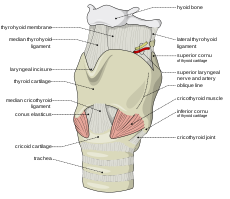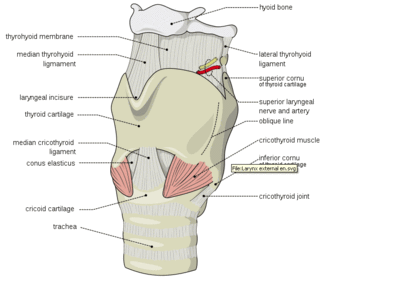- Cricothyrotomy
-
Cricothyrotomy Intervention 
In cricothyrotomy, the incision or puncture is made through the cricothyroid membrane in between the thyroid cartilage and the cricoid cartilage.ICD-9-CM 31.1 MeSH D014140 A cricothyrotomy (also called thyrocricotomy, cricothyroidotomy, inferior laryngotomy, intercricothyrotomy, coniotomy or emergency airway puncture) is an incision made through the skin and cricothyroid membrane to establish a patent airway during certain life-threatening situations, such as airway obstruction by a foreign body, angioedema, or massive facial trauma. Cricothyrotomy is nearly always performed as a last resort in cases where orotracheal and nasotracheal intubation are impossible or contraindicated. Cricothyrotomy is easier and quicker to perform than tracheotomy, does not require manipulation of the cervical spine, and is associated with fewer complications.[1] However, while cricothyrotomy may be life-saving in extreme circumstances, this technique is only intended to be a temporizing measure until a definitive airway can be established.
Contents
Indications
- Can't intubate
- Can't ventilate
- Severe facial or nasal injuries (that do not allow oral or nasal tracheal intubation)
- Massive midfacial trauma
- Possible cervical spine trauma preventing adequate ventilation
- Anaphylaxis
- Chemical inhalation injuries
Contraindications
- Inability to identify landmarks (cricothyroid membrane)
- Underlying anatomical abnormality (tumor)
- Tracheal transection
- Acute laryngeal disease due to infection or trauma
- Small children under 10 years old (a 12–14 gauge catheter over the needle may be safer)
Procedure
 In cricothyrotomy, the incision or puncture is made through the cricothyroid membrane in between the thyroid cartilage and the cricoid cartilage.
In cricothyrotomy, the incision or puncture is made through the cricothyroid membrane in between the thyroid cartilage and the cricoid cartilage.
The procedure was first described in 1805 by Vicq d'Azyr, a French surgeon and anatomist. A cricothyrotomy is generally performed by making a vertical incision on the skin of the neck just below the "Adam's apple", or thyroid cartilage, then making another transverse incision in the cricothyroid membrane which lies deep to this point. One then inserts a tube into this opening, which allows one to breathe for the patient with a machine or bag.
Technique
In a typical cricothyrotomy procedure, a scalpel is used to create a 1 cm vertical incision through the skin and the cricothyroid membrane, and the resulting hole is opened by either inserting the scalpel handle into the wound and rotating 90 degrees or by using a clamp. A tracheostomy tube or endotracheal tube with a 6 or 7 mm internal diameter is then inserted, the cuff is inflated, and the tube is secured. A bag-valve device with the highest available concentration of oxygen is used to provide ventilation, the success of which is assessed by bilateral ausculation and observation of the rise and fall of the chest. No attempts are made to remove the tracheostomy or endotracheal tube in a prehospital setting.[citation needed]
Cricothyrotomy in popular media
On the TV show M*A*S*H, Father Mulcahy performs an emergency cricothyrotomy on a patient. With the direction of Dr. Pierce via radio, he uses a pen knife and an eye dropper to perform the operation. Needless to say, this would be extremely dangerous in real life. Even under ideal, clinical conditions, a cricothyrotomy is difficult and requires specific tools, preparation and a practiced knowledge of anatomy. There are many major blood vessels and nerves in the neck and cutting there, even with the best of intentions carries a high risk of harming the patient.
In the 1980 Nicolas Roeg film "Bad Timing," Theresa Russell's character Milena Flaherty has an emergency cricothyrotomy performed following an intentional overdose.
In Grey's Anatomy, emergency cricothyrotomy is mentioned in at least three episodes:
- In “Owner of a Lonely Heart,” Cristina almost performs an emergency cricothyrotomy on a patient who swallowed a light bulb. Before she is able to do so, however, Dr. Burke shows up and takes the patient to an operating room where he proceeds to perform an emergency thoracotomy.
- In “The Heart of the Matter,” Izzie performs her first “emergency crike” on Camille, a niece of Chief of Surgery Dr. Richard Webber.
- In "I Saw What I Saw" Alex performs a "crike" on the patient who later dies.
In the ER episode, "Reason to Believe" Dr. Kerry Weaver performs an emergency cricothyrotomy on a student. She is shooting a news segment on childhood obesity in an elementary school cafeteria when one of the students begins to choke; after the heimlich maneuver fails, she performs a cricothyrotomy with a kitchen knife and a drinking straw. It is also used many other times, especially in the trauma room, when an airway can't be established.
In the movie, "Playing God" (1997), David Duchovny plays a famed LA surgeon, stripped of his license due to drug abuse, who finds himself witnessing a gun fight at a bar. He saves a mafia crime figure by performing an emergency cricothyrotomy. This endears him with the mafia family and drives the plot forward.
In the BBC3 medical drama Bodies, the main protagonist Rob Lake, a newly appointed obstetrics and gynaecology registrar (played by Max Beesley), is called to a patient who is having difficulty breathing due to anaphylaxis. Lake calls for emergency assistance, but impatient and fearing for the patient's life decides to undertake a cricothyrotomy himself - a procedure he has not been trained in. The procedure is unsuccessful and the patient dies before help arrives. The guilt surrounding the event combined with the covering up by his consultant provides an important backdrop to the further development of the character and his relationship with his consultant.
On Dr.Quinn, Medicine woman; the white man[who?] raised by Indians[who?] who is her lover and companion, performs the procedure on one of Dr.Quinn's boys using a bird's feather (the base where it is hollow). The boy become okay after bird feather in cricothyroid membrane institutes a fresh air supply.
See also
References
- ^ M. Gregory Katos and David Goldenberg (June 2007). "Emergency cricothyrotomy". Operative Techniques in Otolaryngology 18 (2): 110–114. doi:10.1016/j.otot.2007.05.002. http://www.optecoto.com/article/S1043-1810(07)00036-X/abstract. Retrieved 25 July 2010.
- Barone, Jeanine. Tracheotomy. health.enotes.com. URL last accessed February 28, 2006.
- Brookside Associates; US Army Medical department. Cricothyroidotomy. www.brooksidepress.org. URL last accessed February 28, 2006.
- Dorland's Illustrated Medical Dictionary. URL last accessed February 28, 2006.
- Reis, Carlos. Cricothyroidotomy. www.medstudents.com.br. URL last accessed February 28, 2006.
- SIAARTI study committee on the difficult airway. SIAARTI guidelines for difficult intubation and for difficult airway management. anestit.unipa.it. URL last accessed February 28, 2006.
- Mosby's Paramedic Textbook, Edition 3, Mick J. Sanders. 2005, St. Louis, MI: Elsevier Mosby.
External links
- Drawing of a cricothyrotomy
- Smiths Medical Cricothyroidotomy Kits (Cricothyroidotomy products for Adults and Children)
- Medstudents: Procedures: Cricothyrotomy
Respiratory system surgeries and other procedures (ICD-9-CM V3 21-22, 30-34, ICD-10-PCS 0B) Upper RT nose: Rhinoplasty · Septoplasty · Rhinectomy · Rhinomanometry
larynx: Laryngoscopy · Laryngectomy · Laryngotomy (Thyrotomy)Lower RT trachea: Cricothyrotomy · Tracheoesophageal puncture · Tracheotomy
lung: Pneumonectomy · Wedge resection · Lung transplantation · Decortication of lung · Heart-lung transplantChest wall, pleura,
mediastinum, and diaphragmMedical imaging Bronchography · CT pulmonary angiogram · High resolution CT · Spiral CT · Ventilation/perfusion scanCPRs Lung function test Cytology Respiratory therapy/
intubationCategories:- Emergency medical procedures
- Trachea surgery
Wikimedia Foundation. 2010.
